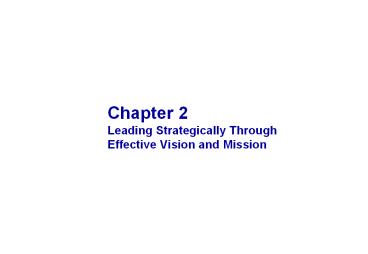Chapter 2 Leading Strategically Through Effective Vision and Mission - PowerPoint PPT Presentation
1 / 19
Title:
Chapter 2 Leading Strategically Through Effective Vision and Mission
Description:
Title: Title Author: Rahman D Khan Keywords: Message Universal Template A4 Description: Version 1.1 Last modified by: Garry Adams Created Date: 8/9/2005 1:23:48 PM – PowerPoint PPT presentation
Number of Views:219
Avg rating:3.0/5.0
Title: Chapter 2 Leading Strategically Through Effective Vision and Mission
1
Chapter 2Leading Strategically Through Effective
Vision and Mission
2
OBJECTIVES
Explain how strategic leadership is essential to
strategy formulation and implementation
1
Understand the relationships among vision,
mission, values and strategy
2
3
Understand the roles of vision and mission in
deter-mining strategic purpose and strategic
coherence
4
Identify a firms stakeholders and explain why
such identification is critical to effective
strategy formula-tion and implementation
Explain how ethics and biases may affect
strategic decision-making
5
3
PULLING A USD 15 BILLION COW OUT OF A DITCH
Xerox reaches profitability
Mulcahy takes over
The fall from the nifty 50
She leads a turnaround
- Xerox introduces the Xerox 914 copier in 1959.
This copier transformed the work place - Xerox was charter member of the nifty 50-50
stocks most favored by institutional investors - Since 1970s, however, Xerox has been crippled by
competition (mostly Japanese)
- October 2001, Xerox reports first quarterly loss
in16 years. Mulcahy is not obvious choice for top
position - She lacks product development and financial
expertise - She gets it because the board has confidence in
her strategic mind. - Roles of 2 people
- Former CEOs Paul Allaire Richard Thoman
- Refines Xerox vision and reminds people of core
values - Aligns operation with the refined mission and
values - Sells Xeroxs China and Hong Kong operations and
half of a stake in a joint venture with Fuji - Closes down inkjet business
- Annual expenses cut by USD 1.7 billion
- Sold USD 2.3 billion worth of non-core assets
- Reduced long-term debt to USD 9.2 billion from
USD 15.6 billion - Xerox returns to profitability in 2002,
generating USD 1.9 billion in operating cash flow
and USD 91 million in net income on USD 15.8
billion in sales
4
STRATEGIC LEADERSHIP
Leadership
Strategic leadership
The task of exerting influence on other peoples
pursuit of goals in an organizational context
Managing an overall enterprise and influencing
key organizational out-comes, such as company
wide performance, competitive superiority,
innovation, strategic change, and survival
5
EXECUTIVE ROLES
Formal authority and status
6
LEVEL 5 LEADERS
Capabilities
Build greatness through combination of will and
humility
Level 5leaders
Can lead a group to superior levels of performance
Level 4 leaders
Organize people resources to accomplish
predetermined objectives
Level 3 leaders
Work effectively with others as a member of a
team to achieve group objectives
Level 2 leaders
Make individual contributions through talent and
work ethic
Level 1 leaders
7
TWO ATTRIBUTES OF LEVEL 5 LEADERS
- Being someone
- who prefers to share credit rather than hog it
- who tends to shun public attention,
- act with calm determination, and
- exercise ambitions on the companys behalf rather
than ones own
- The ability to translate strategic intent into
the resolve needed to pursue a strategy - and usually to make hard choices over a period of
time
Professional modesty
Professional will
8
WHAT DOES IT TAKE TO BE A CEO?
An Ivy league MBA?
Charisma?
There is little consensuson whether personality
or background matters more
International management experience?
Integrity
9
CRITERIA OF AN EFFECTIVE TOP-MANAGEMENT TEAM
- The team responds to a complex and changing
environment. - 2. The team can manage the needs of
interdependent but often diverse units, arenas,
or functional areas. - 3. The team has a valuable and effective social
network. - 4. The team is able to develop a coherent plan
for executive succession.
10
VISION, MISSION AND STRATEGY
Strategy The central, integrated,
externally-oriented concept of how the firm will
achieve its objectives. Consists of 5 elements
arenas, vehicles, differentiators, staging, and
economic logic
Vision and Mission
Strategic Goals and objectives
- Fundamental purpose
- Values
- View of future
- Specific targets
- Measurable outcomes
11
VISION USES OF AMBITION AND AMBIGUITY
Sonys vision in early 1950s becoming the
company that most changes the worldwide image of
Japanese products as being of poor quality.
- Vision statements
- generally express long-term action horizons,
- are ambitious and force the firm to stretch.
- their ambiguity allows flexibility for changing
strategy or implementation tactics
CitiBanks vision in 1915 the most powerful,
the most serviceable, the most far reaching
world financial institution the world has ever
seen.
12
VISION ANCHORED IN GOALS AND OBJECTIVES
Vision
Examples
Goalsand objectives
13
STRATEGY COHERENCE
Congruence
14
STAKEHOLDER ANALYSIS
Stakeholders Individuals or groups who have a
vested interest in an organizations ability to
deliver intended results and maintain the
viability of its products and services
15
MAPPING STAKEHOLDER INFLUENCE AND IMPORTANCE
Importance of Stakeholder
Little/Noimportance
Moderateimportance
Significant importance
Influence ofstakeholder
Unknown
Unknown
Little/Noimportance
Moderateimportance
Significant importance
16
BENEFITS OF USING STAKEHOLDER ANALYSIS
- Can use the opinions of the most powerful
stakeholders to shape your strategy and tactics
at an early stage. - Gain support from powerful stakeholders to help
win more resources. - Can ensure that stakeholders fully understand
what you are doing and understand the benefits of
your project. - Can anticipate what peoples reactions to your
project may be and build actions into the plan
that will win peoples support.
17
Corporate Social Responsibility
- Broader responsibility
- Private corporation has responsibilities to
society that extend beyond making a profit.
18
Corporate Social Responsibility (CSR)
Milton Friedmans Traditional View of
CSR There is one and only one social
responsibility of business to use its resources
and engage in activities designed to increase its
profits Consistent with Agency Theory Views
19
CSR of Business































